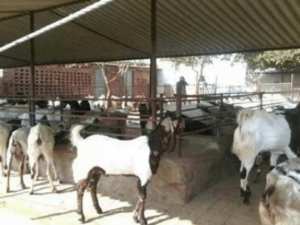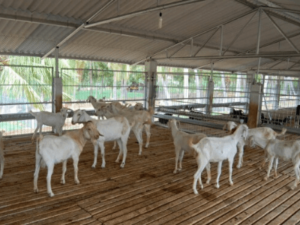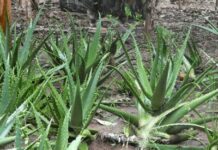
Goat farming in India is a profitable, minimally investment business. In India, goat farming can be done on a small to large industrial scale.
What is Goat farming?
Goat farming is just domestic goats (Capra aegagrus hircus) raising and breeding. This farming is a branch of livestock husbandry. Goats are raised or created primarily for meat, milk, fiber, and skin. Goats are raised in the front yard through the feeding of kitchen leftovers and herbs. They were grown to get household milk consumption and to make goat’s milk ayurvedic medicine. There are many sorts of varieties of goats. Several are perfect for meat that remains of milk goats and there are also breeds specifically for the fur. Goat farming is the most lucrative and these projects attract many farmers.
Goat farming on low-quality pasture land may be suitable for development with other animals, such as sheep and cattle. Goats efficiently turn sub-quality, less suitable grazing matter into quality meat for other livestock. The goats can also be farmed with a relatively restricted pasture area and minimal resources.
 Facts about goat farming:
Facts about goat farming:
- Goat farming in India is a well-established, antique method of farming particularly in places where the system of dryland farming is practiced. Farmers who have a very limited area of land for farming usually do this. Sometimes landless laborers undertake goat farming because the risk, initial investments, etc. are much lower than other forms of agriculture. Goats are therefore rightly known as the “poor man’s cow” since they have promises of good return which can serve as a source of investment.
- Goats are usually reared for milk and meat. Goat is a multi-functional animal and plays a major role in landless and marginal farmers’ economy and nutrition in the country.
- A general rule is that, in about a month, 10 goats will clear an acre. Stocking rates were reported to be as high as 34 goats per acre, though.
- Raising meat goats can be a more profitable small farm venture.
- Jamunapari breed goats are strong milkers and originated in India. They are very good milkers and the daily milk of Jamunapari goats during their lactating season is about 3.5 kg per day. They are a goat really big in scale.
- Goat farming business is really very well suited for profit-making. Goats produce valuable products; they grow quickly and are easily handled. We need much less care and treatment than any other cattle.
- The land requirement for goat farming depends on how many goats there are to be produced or reared. Usually, it takes ten acres of land to raise 500 goats including building shed area. For example, if you’re planning to start with a minimum amount of goats, 50 goats, you’ll need 1 acre of land to rear these.
- A farm of goats is ten times more profitable than a farm of sheep. Goat meat, unlike sheepmeat, has a high demand. Goat marketing is rather easy than sheep marketing.
Steps to Start Goat Farming
1. Goat breed selection plays a major role:
Depending on your goat farming motive you need to choose the right goat breeds for your farm. Usually, peoples raise goats for the reasons given below. First and foremost important things are to select procedures and methods in various stages for the purpose of starting farming which is based on goat or sheep.
There are breeds that produce more milk, depending on your intent, and there are those that grow quickly. You will raise both breeds of goats, and produce both meat and milk. Various breeds need varying degrees of treatment.
- Raising goat for milk
- Raising goat for meat
- Raising goat for hair
- Raising goat for sale as pets.
Especially for beginners who want to start initially and farmers should select bulky goat type, it is really very necessary.

The following are the best goat breeds available in India for milk and meat;
Jamnapari: Jamnapari is India ‘s principal common goat-farming breed. It’s located mainly at Uttar Pradesh. Such goat styles are cute and have good genes. This goat is reared mainly for milk purposes.
Surti: Surti Goat breed is among India’s best dairy breeds. This breed is native to Surat in Gujarat and is small. To the rear, they are mainly economical. Surti female goats are larger than male goats at Surti. These goats are typically in color, white. They ‘re literally handy and graze out in the open field.
Boer Goat: This Boer goat breed has been developed in South Africa, and is the world’s most popular meat breed. They have excellent growth because of selective breeding.
Barbari: The Barbari breed is a dual-purpose breed, reared for the purpose of milk and meat.
Malabari: The Malabari goats are a mixture of different breed types. Malabari goats exhibit premature maturity and conceive in 8 to 10 months.
Sirohi: They are highly heat-resistant, and are found mostly in Rajasthan parts. Sirohi breed is reared for meat production in Uttar Pradesh. Doe typically gives birth twice a year, generally singles 40 percent and twins 60 percent.
Beetal: Often known as Lahori Horse. Beetal has long ears and large body size. Those goats are chosen for intensive goat cultivation.
Osmanabadi: Mostly found in Maharashtra, this breed is also present in Western Maharashtra and adjoining parts of Andhra Pradesh. This goat is reared primarily for milk purposes.
Jakhrana: This type of breed of goats is found primarily in Rajasthan. That is good for both the purposes of milk and meat. In the tanning industry, Jakhrana goat hides are also very popular.
2. Location suitable for goat farming:
Common goats normally survive in well-drained, warm areas. Space is important, in addition to temperature. Some goats live in groups so individual pens don’t function. If you want animals to roam freely a large field is needed. Freely roaming goats generally have better sickness and infection resistance. The best places for a goat farm are those far from towns because urban pollution is dangerous to animal health. Goats are known to eat large amounts of grass at a daily source. So make sure they have a highly accessible food source and not too far from the rearing area.
You should also check local government permission or license-related issues before setting up your goat farm. Choose suitable farmland or area that has the following facilities for goat farming;
- Mud floor is suitable for clean and dry surfaces, except where high rainfall or snow is observed.
- Relaxed and open environment.
- Good source of very clean and freshwater.
- Easily available food source.
- Availability of full-time labor.
- The thing that goats want is cold and heat. Keep them in well-constructed, worm places.
3. Housing or shed for goat farming:
You are sure to reap all the income you want from goat farming with a well-designed housing or shed and good management.
Adequate goat housing or shelter is essential to the business of goat farming. Since goats like other animals do want a house or shed for staying at night, protection, protecting them from adverse climate, cold, sunlight, and so on.
Shedding materials:
When birth happens, your goats will want a quiet place to go. To deposit the goat farm clean and muck out it is important to cover a shed with straw, hay, wood chips, or sawdust.
In addition, regular mucking of all dirty areas is effective in preventing disease maximum. The popular shade types are-General flock shed type (Ewe / Doe shed), room attendant, Ram or buck shed, Lamb or kid shed, Shearing and storeroom, Lambing shed or kidding shed, Sick shed.
 4. Feeding management in goat farming:
4. Feeding management in goat farming:
Goats are thorough eaters and can tolerate more bitterness than other animals. They can, therefore, thrive on the agricultural by-products, waste, and other feed of this sort. They are also stronger, and can, therefore, withstand all kinds of weather conditions. Goat tongues are adapted for grazing and they have a mobile upper lip. So they can graze on very short grasses, bushes, shrubs, and trees. Besides the grains such as pulses, wheat, maize, etc., the goats should be provided with leguminous fodder. They usually prefer leguminous crop fodder to straw or silage maize. They also need at least 14 to 15 percent protein-composed feed along with high mineral composition such as iodized salt, bone meal, zinc oxide, ferrous carbonate, high-grade Silestone, copper, and vitamins. Though adult do and bucks are given concentrate ration of 200 to 250 grams per day, growers are given 100 gm per day of concentrate mixture. On average each goat consumes five to seven kilograms of green fodder and one liter of water per day. Statistically speaking, one acre of fodder suffices for feeding 35 goats.
There are various types of goat food being known as an ideal goat food that is given below;
- Oats, crash corns, and sunflower ‘s black seed is the top mixes and the natural process to make it voluminous.
- It contains so much protein, fiber, hydride carbohydride, oils, and other important things. This helps to keep the body safe. It helps digest quickly in a proper manner.
- Barley and field pea may be ideal food but at least two days of that should soak.
- Then it will be ready to recognize them as food and other livestock grasses are the best goat food.
- Even minerals are a vital component for goats, particularly for goat females.
5. Understanding the breeding and maturity:
Every farmer must have the least information on the maturity of the goats inbreeding. Seven months are suitable for breeding but the weight should be kept from 100 to 105 pounds but one year is ideal breeding time. Pregnant during pregnancy needs to give birth for 150 days (approx.) Two seasons are normally available for breeding between April and August, and pick-time between October and January.
Children are up and going about in these moments of life. They normally decrease dependency on mother’s milk within 2 months. Divide the children from the mother into the teenage compartment at age two to four months. It can happen out of season, it’s quite different. However, according to the doctor’s expertise, occasionally hormone can be used to improve breeding duration.
6. Why should you understand the goat’s behavior?:
There are mainly two types of goats:
Domestic goats (Capra hircus) – raised as indoor farm animals.
Mountain goats (Oreamnos americanus), grow freely as steep, they are suited to places like American Northwest.
Here are some tips to understand your goats;
- The goats are especially the bulk aggressive.
- Aggressiveness is correlated to the structure and size of its horn.
- Goats are social animal and they love people around them.
- Goats can be developed as an indoor pet.
7. Health care in goat farming:
In this business, proper health care and vaccination should be in. Check to get a veterinarian doctor near your farm. If necessary, stock up on your farm some important vaccines and medicines. And vaccinate goats always on time.
Here are some of the tips for caring goats
- Never sit together and buck the do. Because bucks are generally aggressive in nature and could do harm to yours. For breeding purposes, bring your dog to the buck.
- Make sure the latch is out on the fence.
- To learn more about goat care, you can visit a local agricultural extension bureau.
- If you want goat spoiled then the good age to spoil is one week. To dehorn mature goats, ask for vet help.
- Never let goats go outside the fence.
In a word, always try to look after the goats properly and keep them healthy and productive. Thus the business of goat farming will be more profitable.
 8. Commercial Goat Farming License in India:
8. Commercial Goat Farming License in India:
Goat farming is similar to other commercial enterprises. One should be aware of paying goat-farming capital gains when goats fall under the farming business. If you are starting a commercial goat farming business in India, you need to contact the local department of animal husbandry for licensing and other procedures. Talk to your tax consultants about tax on goat-farming profits.
9. Goat Farming Subsidies and Loans in India:
Well, the good news that some government schemes are in place to avail of subsidy for the goat business. NABARD is the principal contact office for various types of subsidies and commercial goat farming loans. There are some popular banks in India such as SBI, ICICI, and HDFC provides loans to set up the goat farm business.
That’s all friends about profitable goat farming business setup in India. Keep raising goats!.
Final Thoughts
Goat farming was once seen as a lowly and neglected occupation. However, it is considered a respected occupation, realizing the benefits of goat milk, meat, and other by-products. There are several under-investment companies among which goat farming tops the list. Goat farming is a good starting point especially for the unemployed youth whose number is simply increasing by the day.
See Also

 Facts about goat farming:
Facts about goat farming: 4. Feeding management in goat farming:
4. Feeding management in goat farming: 8. Commercial Goat Farming License in India:
8. Commercial Goat Farming License in India:




